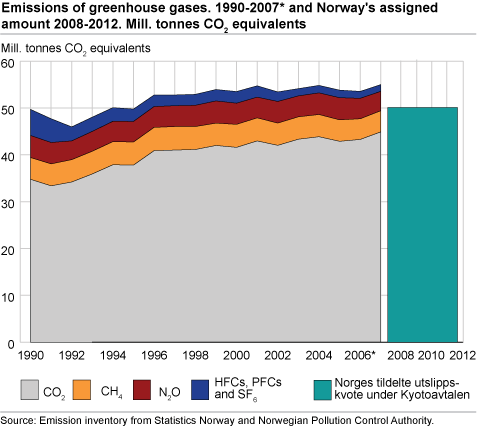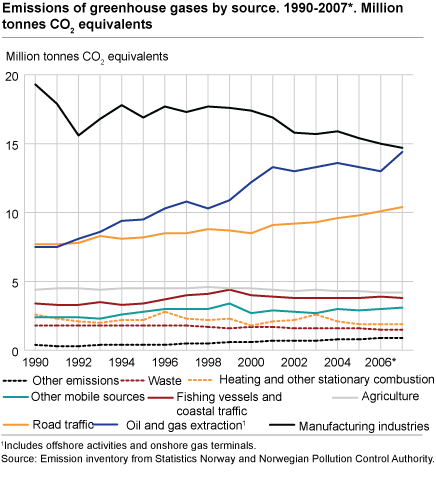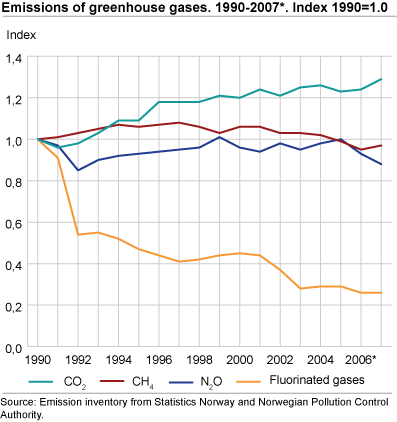Content
Published:
This is an archived release.
Strong increase in greenhouse gas emissions
Following two years of decrease, emissions of greenhouse gases (GHG) increased by almost 3 per cent in 2007. The Norwegian emissions have never been higher.
The increase is mainly due to CO2 emissions from flaring at the new LNG plant at Melkøya. Continued growth in road traffic and increased metal production also contributed to the increase in emissions, while a decrease in crude oil production and installations of new technology in the manufacturing industry partly offset the increase.
These are some of the results found in the new, preliminary emission figures produced by Statistics Norway in close cooperation with the Norwegian Pollution Control Authority.
Total Norwegian GHG emissions reached 55.0 million tonnes CO2 equivalents in 2007. This is an increase of 1.5 million tonnes CO2 equivalents (2.7 per cent) from 2006, and an increase of close to 11 per cent compared to 1990. Following two years of decrease in the emissions, partly due to a decline in crude oil production, the emissions were somewhat higher than in the previous peak year of 2004. The most important factor contributing to this increase was technical difficulties in the initialisation of the LNG plant at Melkøya outside Hammerfest.
The manufacturing industry, petroleum industry, and road traffic are the largest contributors to GHG emissions in Norway, accounting for 72 per cent of the total emissions in 2007.
Increasing emissions from petroleum industry
Slightly more than 1.6 million tonnes CO2 were emitted from Melkøya in 2007, of which the main part was due to flaring due to production difficulties. The emissions are expected to be about 1 million tonnes CO2 when the production runs as planned. The emissions from other parts of the petroleum industry continued to decrease in 2007 due to lower production of crude oil. In spite of lower production, the activity at Melkøya led to an increase of almost 11 per cent in the total emissions from 2006 to 2007. The GHG emissions from the petroleum industry almost doubled from 1990 to 2007.
Increasing GHG emissions from road traffic
The emissions from road traffic continued to increase in 2007 as a result of traffic growth. 10.4 million tonnes CO2 equivalents were emitted from this source in 2007, a 3 per cent increase from the previous year. Road traffic accounted for 19 per cent of total Norwegian GHG emissions. When other types of transportation are included, such as domestic air traffic, domestic sea transport, and railroads, this activity accounts for around 32 per cent of the GHG emissions.
Improvements in technology and a shift from petrol to diesel vehicles have resulted in an increase in emissions that is smaller than the increase in traffic. The shift to diesel vehicles has been stimulated by the introduction of a higher non-recurring duty for petrol cars in 2007. Three out of four sold passenger cars were diesel-powered in 2007. This is a strong increase from 2006, when just above half of new passenger cars were diesel-powered.
New technology resulted in lower emissions from manufacturing industry
In spite of increased activity and increased GHG emissions from metal production, total emissions from the manufacturing industry decreased from 15 million tonnes CO2 equivalents in 2006 to 14.7 million tonnes CO2 equivalents in 2007. This was mainly due to the emphasis on environmental technology in the chemical industry.
CO2 is still the main problem
Greenhouse gases include the six gases covered by the Kyoto Protocol (see box): carbon dioxide (CO2), methane (CH4), nitrous oxide (N2O) hydrofluorocarbons (HFCs), perfluorocarbons (PFCs) and sulphur hexafluoride (SF6). In 2007, CO2 accounted for more than 82 per cent of total GHG emissions measured by tonnes of CO2 equivalents, whereas methane and nitrous oxide accounted for almost 16 per cent. Fluorinated gases accounted for slightly less than 3 per cent of the total emissions in 2007. Since 1990, the CO2 emissions have increased by 29 per cent, whereas emissions of fluorinated gases have fallen by 74 per cent.
Preliminary figuresThe figures presented in this article are preliminary, but are relatively reliable. This especially applies to the figures for total emissions. Final figures will be published in February 2009. Documentation of the emission accounts |
The Kyoto Protocol and Norway’s commitmentIndustrialised countries that have ratified the Kyoto protocol have been given so-called AAU quotas (Assigned Amount Units) for the period 2008-2012. If the countries’ emissions exceed the assigned amounts, they must buy quotas through the Kyoto mechanisms in order to supplement national emission reductions. This may imply buying quotas assigned to other industrialised countries or financing approved projects for emission reduction in developing countries (CDM - Clean Development Mechanism). Norway’s assigned amount for the period 2008-2012 is 250.6 million tonnes CO2 equivalents (1 per cent more than the 1990 emission for each year 2008-2012). In 2007, Norway's GHG emissions totalled 55.0 million tonnes CO2 equivalents. Projections from the Norwegian Government indicate that Norway's emissions may rise to 58.5 million tonnes CO2 equivalents in 2010 (Prognosis: Report No. 1 (2007-208) to the Storting: The National budget 2008). If the emissions remain on the 2010 level throughout the Kyoto period, Norway will need to buy quotas for 42 million tonnes CO2 equivalents in the period 2008-2012. |
Other relevant articles
Go to article on emissions of NOx and NMVOC
Tables:
This page has been discontinued, see Emissions to air, Annually.
Contact
-
Trude Melby Bothner
E-mail: trude.melby.bothner@ssb.no
tel.: (+47) 40 81 14 25
-
Berit Storbråten
E-mail: berit.storbraten@ssb.no
tel.: (+47) 40 81 14 23



